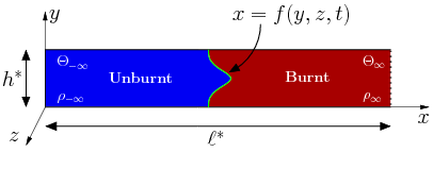Combustion instabilities
|
 Example of engine failures due to combustion instabilities (photos from Lieuwen, 2005)
Example of engine failures due to combustion instabilities (photos from Lieuwen, 2005)
Brief overview
Combustion is essential to energy generation and transport needs, and will remain so for the foreseeable future. Mitigating its impact on the climate and human health, by reducing its associated emissions, is thus a priority. One suggested strategy to reduce NOx is to operate combustors at lean conditions. Unfortunately, combustion instability is more likely to occur in the lean regime, and may have catastrophic consequences on the components of combustion chambers, such as vibrations and structural fatigue. Ramjet engines, rocket engines and in general any type of gas turbine engines may be subject to this detrimental instability. The ability to predict and control the instability is crucial for implementing the lean burn strategy.
Combustion is essential to energy generation and transport needs, and will remain so for the foreseeable future. Mitigating its impact on the climate and human health, by reducing its associated emissions, is thus a priority. One suggested strategy to reduce NOx is to operate combustors at lean conditions. Unfortunately, combustion instability is more likely to occur in the lean regime, and may have catastrophic consequences on the components of combustion chambers, such as vibrations and structural fatigue. Ramjet engines, rocket engines and in general any type of gas turbine engines may be subject to this detrimental instability. The ability to predict and control the instability is crucial for implementing the lean burn strategy.
 Diagrammatic illustration of a flame propagating in a duct
Diagrammatic illustration of a flame propagating in a duct
Combustion instabilities are characterised by strong self-sustained oscillation between the acoustic pressure and the flame within a combustion chamber. Hence, they involve an intricate interplay of several key physical processes, which take place in regions of different length scales. In particular, it is important to understand the interplay and coupling between flames, acoustic waves and hydrodynamic flow. Due to this multi-scale, multi-physics nature of the problem, direct numerical simulations of realistic combustors are extremely challenging. For this reason, simplified mathematical models capturing qualitatively and quantitatively the main characteristics of combustion instability are essential. In particular, by exploiting the scale disparity, systematic asymptotic analysis may be carried out to derive relevant models on first principles, and to provide guidance for developing reliable and efficient numerical algorithms.
Recent progress have been made in the mathematical modelling of such instabilities, using refining and implementing this model would make a good PhD project.
If you want to learn more about this, here is a youtube video of a seminar given by Raphael Assier.
- R. C. Assier and X. Wu. Linear and weakly nonlinear instability of a premixed curved flame under the influence of its spontaneous acoustic field. J. Fluid Mech., volume 758, pp 180-220, 2014 (open access)
- R. C. Assier and X. Wu. A combustion instability model accounting for dynamic flame-flow-acoustic interactions. In 7th AIAA Theoretical Fluid Dynamic Conference, AIAA 2014-3342, number June, pages 1-15, 2014.
- C. M. Luzzato, R. C. Assier, A. S. Morgans, and X. Wu. Modelling thermo-acoustic instabilities of an anchored laminar flame in a simple lean premixed combustor: including hydrodynamic effects. 19th AIAA/CEAS Aeroacoustics Conference, 2013-2003:1-15, 2013.
Our collaborators
- Prof. Xuesong Wu, Imperial College London
- Dr. Aimee Morgans, Imperial College London